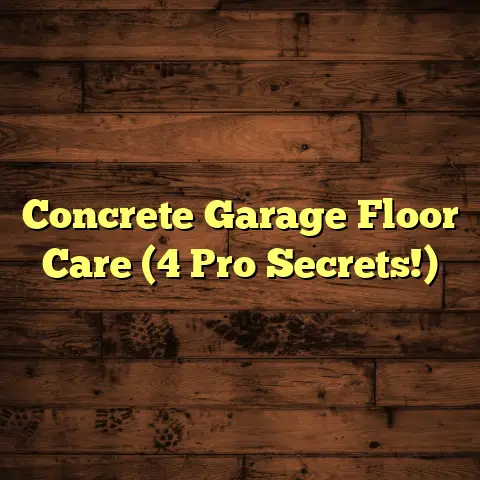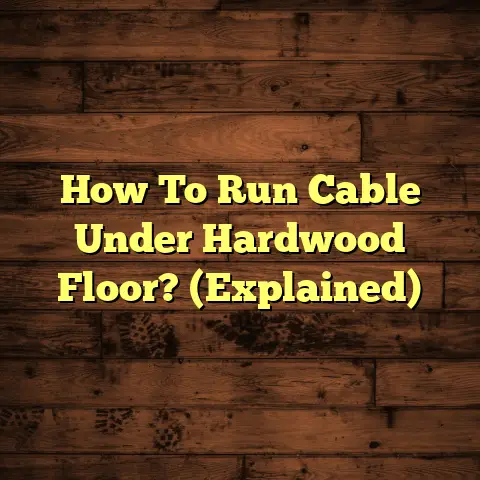Fit Edging Strip to Laminate? (7 Gaps to Avoid!)
Remember that feeling? Stepping onto a brand-new laminate floor.
Maybe it was in your childhood home, or a friend’s place.
That warmth underfoot, the smooth, wood-like finish.
Flooring does hold memories, doesn’t it?
Family gatherings, quiet moments alone…
It’s important to maintain that beauty, that functionality.
And that’s where edging strips come in.
They’re not just a necessity, they complete the look.
But a bad fit? Gaps?
That can ruin everything.
Not just aesthetically, but it can also lead to more damage in the long run!
Let’s dive in and make sure that doesn’t happen to you.
Section 1: Understanding Edging Strips
1. Definition and Purpose
What are edging strips, anyway?
Well, think of them as the finishing touch.
These gaps are crucial, because laminate needs room to expand and contract with temperature and humidity changes.
Without them, your floor could buckle!
Edging strips hide these gaps, protect the edges of your flooring from damage, and give your room that clean, professional finish.
Think of them like the frame around a beautiful painting.
2. Types of Edging Strips
There’s more than one type, you know!
Here’s a quick rundown:
-
T-Molding: This is used where two laminate floors meet, especially if they’re at the same height. It creates a smooth transition.
-
Reducer Strips: These bridge the gap between laminate and a lower floor surface, like tile or vinyl.
-
Quarter-Rounds: These are small, rounded moldings that fit snugly against the wall and the floor.
-
Thresholds: These are used at doorways to transition between different types of flooring or to cover expansion gaps.
Choosing the right type depends on your specific situation and the look you’re going for.
Section 2: Importance of Proper Installation
1. Foundation of a Good Finish
Think of it this way:
You can have the most beautiful laminate in the world, but if your edging strips are poorly installed, it’ll ruin the whole look. Gaps are awful!
They’re unsightly, they collect dirt, and they just scream “amateur job.”
Proper installation is the foundation of a polished, professional finish.
It’s the difference between a floor you’re proud of and one you want to hide.
2. Long-Term Benefits
It’s not just about looks, though.
Correctly fitted edging strips offer long-term benefits:
-
Preventing Moisture Damage: Gaps can allow moisture to seep under your laminate, causing it to warp, swell, or even develop mold.
-
Reducing Risk of Injury: Exposed edges can be sharp and dangerous, especially for kids and pets.
-
Maintaining Integrity: Properly installed strips help keep your laminate floor stable and prevent it from shifting or coming apart over time.
It’s an investment in the longevity and beauty of your floor.
Section 3: The 7 Gaps to Avoid When Fitting Edging Strips
Okay, let’s get down to business.
These are the seven deadly gaps you absolutely must avoid:
1. Gap 1: Incorrect Measurement
Explanation:
Measurement is everything.
If you don’t measure accurately, your edging strips will be too short or too long, leaving unsightly gaps.
I’ve seen it happen so many times.
Common Mistakes:
-
Rounding Up/Down: Always measure to the nearest 1/16th of an inch. Rounding can add up, especially over longer runs.
-
Not Accounting for Corners: Corners aren’t always perfectly square. Use a protractor to measure the angle and adjust your cuts accordingly.
-
Measuring Only Once: Measure twice, cut once. It’s an old saying, but it’s true!
How to Avoid:
Use a high-quality measuring tape. Double-check your measurements.
And don’t be afraid to use a laser measuring tool for extra accuracy.
I personally use Bosch Blaze 165′ Laser Distance Measurer, it gives me the exact measurement.
2. Gap 2: Improper Cutting Techniques
Explanation:
A jagged, uneven cut is a surefire way to create gaps.
Edging strips need to be cut cleanly and precisely to fit snugly against the wall or other flooring.
Common Mistakes:
-
Using the Wrong Tool: A dull saw blade or the wrong type of saw can tear the material instead of cutting it cleanly.
-
Rushing the Cut: Trying to cut too quickly can lead to mistakes and uneven edges.
-
Not Using a Miter Box: A miter box helps you make accurate angled cuts, which are essential for corners.
How to Avoid:
Use a sharp saw blade designed for the material you’re cutting.
Cut slowly and carefully, and always use a miter box for angled cuts.
I usually use a power miter saw for a cleaner, more precise cut.
3. Gap 3: Neglecting Expansion Gaps
Explanation:
As I mentioned earlier, laminate flooring needs room to expand and contract.
If you install your edging strips too tightly against the wall, you’ll prevent the floor from moving, which can lead to buckling or, ironically, gaps appearing elsewhere.
Common Mistakes:
-
Installing Edging Strips Flush with the Wall: Always leave a small gap (usually about 1/4 inch) between the edging strip and the wall.
-
Using Too Much Adhesive: Too much adhesive can restrict the floor’s movement.
How to Avoid:
Use spacers to maintain a consistent expansion gap.
Apply adhesive sparingly, and only where it’s needed.
4. Gap 4: Misalignment During Installation
Explanation:
Even if your measurements and cuts are perfect, misalignment during installation can create noticeable gaps.
This is especially true when installing longer runs of edging strips.
Common Mistakes:
-
Not Using a Level: Uneven floors can make it difficult to align edging strips properly.
-
Rushing the Installation: Trying to install too quickly can lead to mistakes and misalignment.
How to Avoid:
Use a level to ensure that your edging strips are straight and even.
Take your time and work carefully, making sure each piece is properly aligned before securing it.
5. Gap 5: Inadequate Adhesive Application
Explanation:
Adhesive is what holds your edging strips in place.
If you don’t apply enough adhesive, or if you use the wrong type, the strips can loosen over time, creating gaps.
Common Mistakes:
-
Using the Wrong Type of Adhesive: Different materials require different types of adhesive.
-
Applying Too Little Adhesive: Not enough adhesive won’t provide a strong bond.
-
Applying Adhesive to a Dirty Surface: Dirt and debris can prevent the adhesive from bonding properly.
How to Avoid:
Use a high-quality adhesive that’s specifically designed for the material you’re working with.
Apply a generous amount of adhesive to both the edging strip and the subfloor.
Make sure the surfaces are clean and dry before applying adhesive.
6. Gap 6: Ignoring Floor Movement
Explanation:
Laminate flooring is constantly shifting and expanding, especially with changes in temperature and humidity.
If you don’t account for this movement during installation, it can create gaps over time.
Common Mistakes:
-
Installing Edging Strips Too Tightly: As mentioned earlier, leaving an expansion gap is crucial.
-
Using Rigid Fasteners: Nails or screws can restrict the floor’s movement.
How to Avoid:
Use flexible adhesive that allows for some movement.
Avoid using rigid fasteners whenever possible.
7. Gap 7: Skipping Final Inspection
Explanation:
Once you’ve installed your edging strips, it’s tempting to call it a day.
But a thorough final inspection is essential to catch any missed gaps or other imperfections.
Common Mistakes:
-
Not Looking Closely Enough: Gaps can be small and easy to overlook.
-
Not Checking Corners and Transitions: These are the most common areas for gaps to appear.
How to Avoid:
Take your time and carefully inspect all of your edging strips, paying close attention to corners and transitions.
Use a flashlight to highlight any gaps or imperfections.
Section 4: Troubleshooting Common Issues
1. Identifying and Fixing Existing Gaps
So, you’ve got gaps. Don’t panic!
Here’s how to identify and fix them:
-
Visual Inspection: Start by carefully examining your edging strips, looking for any gaps, cracks, or loose areas.
-
Mark the Gaps: Use a pencil to mark the areas that need to be repaired.
-
Remove Loose Strips: If the edging strip is loose, carefully remove it using a pry bar or putty knife.
-
Clean the Area: Remove any dirt, debris, or old adhesive from the subfloor.
-
Apply New Adhesive: Apply a generous amount of new adhesive to the edging strip and the subfloor.
-
Reinstall the Strip: Carefully reinstall the edging strip, making sure it’s properly aligned.
-
Fill Small Gaps: For small gaps, you can use wood filler or caulk that matches the color of your edging strips.
2. Tools and Materials Needed
Here’s a list of essential tools and materials for installing and fixing edging strips:
- Measuring Tape
- Miter Saw or Hand Saw
- Miter Box
- Level
- Pry Bar or Putty Knife
- Adhesive
- Wood Filler or Caulk
- Spacers
- Safety Glasses
- Gloves
Conclusion: The Finishing Touch
Fitting edging strips correctly is the final, crucial step in any laminate flooring project.
Avoiding those seven gaps I mentioned will not only enhance the beauty of your floor but also preserve the memories created in that space.
A well-installed edging strip is a testament to your attention to detail and your commitment to creating a home you love.
So, take your time, be careful, and take pride in your work.
You got this!





